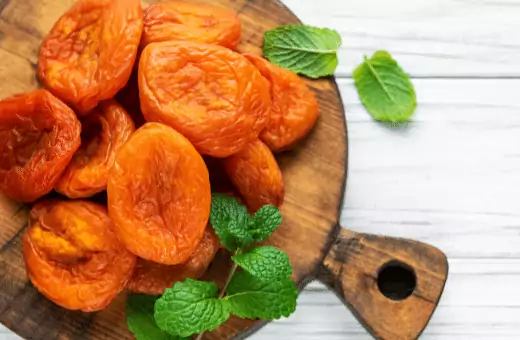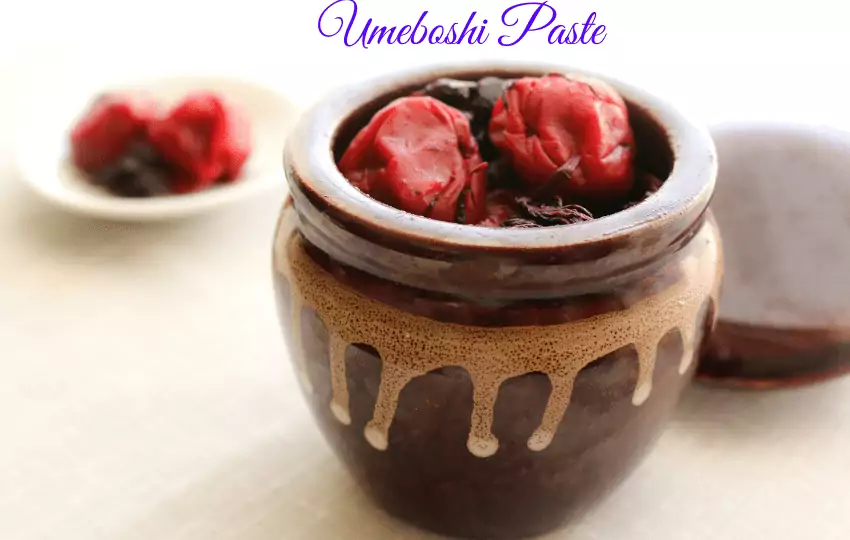Do you want the vegan-friendly Umeboshi paste taste in your recipe? Try below substitute for Umeboshi paste; they give you a similar taste to Japanese plum pickle.
Note that all alternatives are not vegan, so choose according to your deal.
What is Umeboshi Paste?
Umeboshi Paste is a Japanese condiment made from ume fruits that have been pickled in shiso leaves and salt.
The tart, sour flavor of the paste pairs well with rice and other savory dishes. Umeboshi paste can be purchased at most Asian markets or online.
The paste has a salty, sour, and slightly sweet taste and is often used as a spread or dip. It can also be added to dishes for flavor.
Umeboshi Paste Ingredients: Pureed, fermented Japanese ume plums, Red shiso, Salts.
What do umeboshi taste like?
Some people say that they taste sour, salty, and a little sweet. They are often eaten as a snack or used as a condiment in Japanese cooking. Some people also use them to make pickles.
Substitute for Umeboshi Paste
1. DRIED APRICOT PASTE -A Perfect Umeboshi Paste Alternative
Dried Apricot paste is the best and good to go Umeboshi substitute. Because Ume fruit exactly look and taste like apricot.

The dried apricot paste is a popular Middle Eastern ingredient used in many dishes.
Apricot paste is prepared by drying apricots and crushing them into a paste. This paste is suitable for use as a relish or a dip.
Dried apricot paste has a sweet and tart flavor that goes well with many dishes. It can add flavor to heavy meat dishes or serve as a light, fruit-flavored condiment with lighter fare. Its sweet taste means that it is also suitable for desserts.
The dried apricot paste can be made at home, but it is time-consuming to produce the paste from scratch.
A few manufacturers sell dried apricot paste if you want to save time and enjoy your dried apricot paste without creating it yourself.
If you have never tried dried apricot paste before, we suggest starting with a small amount.
It is a very strong flavor and can be overpowering if you are not used to it.
Once you taste it, we are sure you will love the unique flavor it adds to your dishes.
2. Use MIXTURE OF TAMARIND+ SALT+ DRY CHILI PASTE Instead of Umeboshi Paste
The tamarind mixture, salt, sugar, and dry chili convey your dish to another level. Trust me, when I don’t have anything, I often make the simple paste and apply plates call for Umeboshi.
If you want to avoid sugar & its calorie intake, try some natural sugar substitute here, giving the same result.
Tamarind is naturally tart flavor and creamy consistency. Make sure always start with a small amount. 4 Bunch of tamarind pods, 1 teaspoon of salt, chili as you want the spiciness, and sugar from 1 tablespoon and water.
Mix the whole ingredients in a grinder or food processor. The seeds of tamarind should remove before use.
Tamarind increases the tart flavor. If you don’t have tamarind yet, use Soy sauce or miso paste instead.
Keep the paste in a cool, dry, airtight jar in the fridge for up to a week.
3. Try KIAMOY or CHAMOY as a Substitute for Umeboshi Paste
Kiamoy or Chamoy (name varies from country to country) is another good substitute for umeboshi paste.
Chamoy is basically popular Mexican candy made from apricots, sugar, and chile powder. Chamoy is often served on a stick like a lollipop or as a dip for fruit or pretzels.
The taste of Chamoy can be described as a sweet and sour mix with a strong chili flavor. It’s a popular Mexican snack and is often served on a stick like a lollipop or as a dip for fruit.
4. A Easy Umeboshi Plum Paste Substitute- AMBA PASTE
Amba paste, Amba paste nothing but the mango pickle paste similar taste and consistency to umeboshi.
You can use it as a dipping sauce, served with rice. To know more about amba paste, I have detailed one ( Check here.)
5. Bring Some kick With ANCHOVY PASTE Replacement of Umeboshi Paste
Though anchovy paste is not vegan, it is an excellent alternative for use. At the same time, you don’t have umeboshi in your kitchen.

Anchovy paste is a thick, salty sauce made from anchovies, oil, and spices. It is used as a condiment to add flavor to food.
Anchovy paste can be used in various dishes, including pasta sauces, pizza toppings, and salads. It is also frequently used in marinades for meat or fish.
Check out for Best Anchovy Paste alternatives ( Vegan Friendly)
Anchovy paste is sold in tins or tubes. It can be kept at room temperature for several months. Still, it should be refrigerated after opening the container to prevent spoilage.
6. MISO PASTE for Umeboshi Paste
Miso is a vegan umeboshi substitute, a traditional Japanese seasoning condiment with a similar tarty flavor to umeboshi.
Soybeans, salt, and the fungus kojikin are fermented to make it.
Miso has a unique, slightly sweet, umami taste that can be described as being both salty and earthy at the same time.
It is high in protein and rich in essential amino acids, including methionine, vital for liver health.
Miso is a versatile ingredient used in both savory and sweet dishes. It can be added to soups, stews, sauces, or marinade for meat or fish.
Miso also makes a great addition to rice dishes or desserts.
There are many different types of miso available on the market, each with its own flavor and color.
The most common type is white miso, which has a mild, slightly sweet flavor.
Other popular varieties include red miso, which has a stronger, saltier flavor, and black miso, fermented for a more extended period and a more prosperous, more earthy flavor.
What are the uses of Umeboshi Paste?
There are many different ways to use umeboshi paste. It can be used as a condiment on rice, pasta, or other dishes.
Umeboshi paste can also be used as a pickle or a marinade. It is a great way to add flavor and salt to food.
Umeboshi paste can be added to recipes, like soups and stir-fries, to make them more flavorful. It’s a great dipping sauce for sushi and sashimi.
Umeboshi paste can also be used in place of salt or soy sauce on meat, tofu, vegetables, rice, and other dishes. It can also be mixed with water to make a refreshing drink.
What is umeboshi paste good for?
As mentioned earlier, umeboshi paste is a great way to add flavor to dishes while providing essential nutrients. Additionally, umeboshi paste can be used as a natural remedy for various health issues.
For example, it can help relieve nausea and indigestion, nausea, vomiting, etc. Umeboshi is an alkaline food and helps balance the body’s pH levels.
How to make umeboshi paste at Home
You can make your own umeboshi paste at home in simple steps.
Ingredients:
- · 1 cup dried umeboshi plums, pits removed
- · 2 cups water
- · 1/2 cup brown rice vinegar or white distilled vinegar
- · 1/4 cup honey
- · 1 teaspoon salt
Instruction:
1. Combine the dried plums and water in a medium saucepan. Bring to a boil, lower the heat and cook for 20 minutes. Drain thoroughly.
2. Place the plums in a blender or food processor with vinegar, honey, and salt. Puree until smooth.
Store the umeboshi paste in an airtight container in the refrigerator for up to two weeks. It will keep for longer, but the flavor will diminish over time.
How long does umeboshi paste last
Umeboshi paste can last for up to six months when stored in a cool, dry place.
However, it may start to lose its effectiveness over time. It’s best to use umeboshi paste within a few months of opening the jar, if possible.
What can I use in place of umeboshi plum vinegar?
Suppose you’re looking for a substitute for umeboshi plum vinegar. In that case, you can try using apple cider vinegar or rice wine vinegar.
Both of these substitutes will give your dish a slightly different flavor, but they will still be effective in helping to add a sour tanginess to your dish.
Alternatively, you can also use lemon juice as a substitute. However, this will not be as sour as umeboshi plum vinegar.
Ultimately, it’s up to you to decide which substitute works best for your recipe. Experimentation may be necessary!
Is Hoisin the same as plum sauce?
The answer is no. Hoisin sauce is actually a thick, dark brown sauce made by fermenting soybeans with wheat flour, salt, sugar, and vinegar.
It is traditionally used in Chinese cooking to enhance the flavors of meat dishes such as spare ribs or duck. Some common uses for Hoisin sauce are spring rolls, egg rolls, or barbeque meat.
Hoisin sauce is not confused with plum sauce, also known as duck sauce or Chinese plum sauce. Plum sauce is a condiment containing ingredients such as plums, apricots, and sugar; it can be hot or sweet.
It is often served alongside Peking Duck (Beijing Roast Duck) as a dipping sauce or used in stir-fries. Plum sauce can be used as a meat or fish glaze.
So, while Hoisin and plum sauces share some similarities – both being sauces used in Chinese cuisine – they are two separate sauces with unique flavors.
If you’re looking to add a bit of Chinese flavor to your cooking, be sure to give Hoisin sauce a try!
Wrap Up On Umeboshi Paste Substitute
When you cannot get umeboshi in your area, or if you would like to try making your own for some reason, here is an easy substitute that tastes pretty close.
I use this when I make my sushi rice. It doesn’t taste precisely the same, but it has a nice flavor, and with enough soy sauce, it’s difficult to tell the difference.

